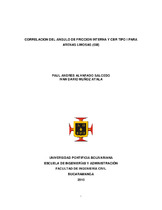Mostrar el registro sencillo del ítem
Correlación del ángulo de fricción interna y CBR tipo I para arenas limosas (SM)
| dc.contributor.advisor | Bautista García, Gerardo | |
| dc.contributor.author | Alvarado Salcedo, Paul Andrés | |
| dc.contributor.author | Muñoz Ayala, Ivan Dario | |
| dc.coverage.spatial | Seccional Bucaramanga. Universidad Pontificia Bolivariana. Escuela de Ingenierías. Facultad de Ingeniería Civil | spa |
| dc.coverage.temporal | 2010 | |
| dc.date.accessioned | 2013-08-28T16:59:40Z | |
| dc.date.available | 2013-08-28T16:59:40Z | |
| dc.date.created | 2010-08-09 | |
| dc.date.issued | 2013-08-28 | |
| dc.identifier.uri | http://hdl.handle.net/20.500.11912/890 | |
| dc.description | 61p.: (pdf); il; gráficas; tablas; anexos | spa |
| dc.description.abstract | Esta tesis tuvo como objetivo principal la determinación de la relación entre el ángulo de fricción interna y el CBR tipo I para arenas limosas mediante la realización de los ensayos de corte directo y ensayo de CBR (california Bearing Ratio) tipo I. El trabajo comenzó con la selección del material el cual se tomó del sector donde se encuentra el muro en tierra armada en la parte superior del Bloque D. Una vez seleccionado el material se procedió a realizar los ensayos de clasificación para corroborar que efectivamente se tratara de arenas limosas (SM). Posteriormente se realizaron los ensayos de compactación para determinar la humedad óptima; conocida la humedad optima se procedió a realizar 90 ensayos de corte directo y 90 ensayos de CBR tipo, de los cuales la tercera parte se realizaron con muestras compactadas con una humedad de 8,5%, otra tercera parte con una humedad de 12,5% y una tercera parte adicional con una humedad de 16,5%. Con los resultados de los ensayos de corte directo y CBR tipo I se buscaron tendencias entre las diferentes propiedades físicas de las arenas limosas estudiadas, para finalmente hacer las conclusiones y recomendaciones respectivas. | spa |
| dc.description.abstract | The objective of this work was to determinate the relation between the internal rub angle and CBR type I to slimy sands, realizing direct cut tests and CBR type I tests (California Bearing Ratio)- This work began selecting material, which was taking in the sector where the armada soil wall on the top of building D. is When the material was selected, was realized the classification tests to prove that the samples was slimy sands. Then was realized the compact tests to determine the optimal humidity; knowing the optimal humidity, was realizing 90 direct cut tests and 90 CBR test type I, which the third part was made with compact samples with an optimal humidity of 8.5%, other third part with an optimal humidity of 12.5% and another third part with an optimal humidity of 16.5%. With the results of the direct cut and CBR type I tests, looking for tendency between the different slimy sand’s physicals properties, to finally made the conclusions and recommendations. | |
| dc.language.iso | es | |
| dc.publisher | Universidad Pontificia Bolivariana | spa |
| dc.rights | Attribution-NonCommercial-NoDerivatives 4.0 International | * |
| dc.rights.uri | http://creativecommons.org/licenses/by-nc-nd/4.0/ | * |
| dc.subject | Tesis y disertaciones académicas | spa |
| dc.subject | Ingeniería civil | spa |
| dc.subject | Arenas limosas | spa |
| dc.subject | Fricción interna | spa |
| dc.title | Correlación del ángulo de fricción interna y CBR tipo I para arenas limosas (SM) | spa |
| dc.type | bacherlorThesis | spa |
| dc.rights.accessRights | openAccess | spa |
| dc.type.hasVersion | publishedVersion | spa |
| dc.identifier.instname | instname:Universidad Pontificia Bolivariana | spa |
| dc.identifier.reponame | reponame:Repositorio Institucional de la Universidad Pontificia Bolivariana | spa |
| dc.identifier.repourl | repourl:https://repository.unab.edu.co/ |
Ficheros en el ítem
Este ítem aparece en la(s) siguiente(s) colección(ones)
-
Trabajos de grado [6691]
Monografías, artículos, informes, proyecto de grado


